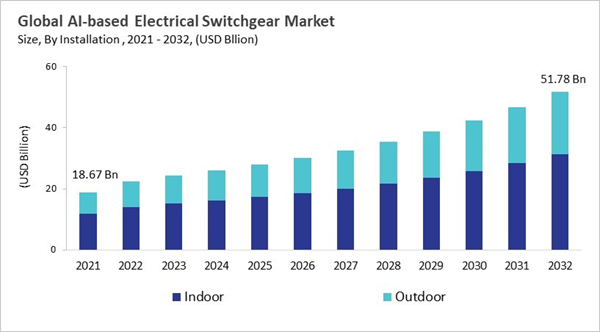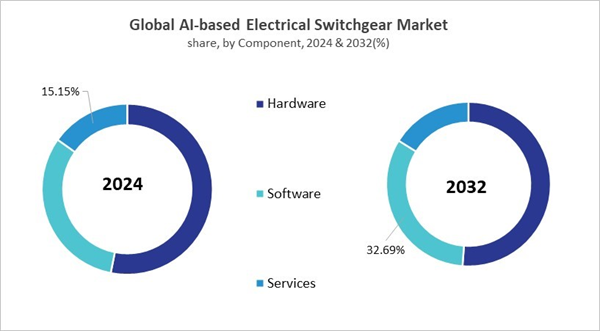Key Highlights:
- The North America market dominated Global AI-based Electrical Switchgear Market in 2024, accounting for a 39.62% revenue share in 2024.
- The U.S. market is projected to maintain its leadership in North America, reaching a market size of USD 15.66 billion by 2032.
- Among the Component, the Hardware segment dominated the global market, contributing a revenue share of 53.10% in 2024.
- In terms of Installation, Indoor segment are expected to lead the global market, with a projected revenue share of 60.48% by 2032.
- The Low Voltage market emerged as the leading Type in 2024, capturing a 39.64% revenue share, and is projected to retain its dominance during the forecast period.
- The Industrial Market in End User is poised to grow at the market in 2032 with a market size of USD 15.94 billion and is projected to maintain its dominant position throughout the forecast period.
The AI-based electrical switchgear market has evolved from a generic digital monitoring into a smart grid ecosystem driven by embedded intelligence, edge analytics, and cloud orchestration. In addition, the growing power consumption is providing growth opportunities to the market. As per the Our World in Data, global energy consumption continues to grow - averaging around 1% to 2% per year. This data shows the increasing rate of power consumption which will impact the global market positively. Furthermore, technological advancements in standardized communication protocols and edge computing prioritize switchgear to actively support grid resilience, load balancing, and distributed energy resource management. New methods such as Modern software subscription models, analytics-as-a-service, and performance-based contracts are revolutionizing revenue sources, highlighting the from pure hardware sales to digital-first business models aligned with energy efficiency and sustainability goals.
Key market trends are the use of AI-driven predictive maintenance to cut down on downtime and lifecycle costs, the integration of switchgear into digital energy ecosystems, and the growth of software-based business models that are supported by partnerships with cloud providers and hyperscale data centers. Top OEMs are speeding up adoption by putting sensors and edge processors into their products, creating platformized software services, and forming strategic partnerships. Competition is getting tougher as traditional OEMs protect themselves with integrated hardware-software portfolios, while new tech companies and industrial AI startups push for new ideas at the software level. The result is a competitive environment that is always changing. To be successful, you need to be able to work with other systems, keep them safe, and provide flexible, outcome-based solutions for power systems that are strong and digital.
Driving and Restraining Factors
Drivers
- Rising Demand For Grid Modernization And Smart Infrastructure
- Integration Of Renewable Energy And Distributed Energy Resources
- Growing Importance Of Predictive Maintenance And Operational Efficiency
- Increasing Demand From Data Centers And Digital Industries
Restraints
- High Initial Investment And Implementation Costs
- Cybersecurity And Data Privacy Concerns
- Lack Of Standardization And Interoperability Challenges
Opportunities
- Expansion Of Smart Cities And Digital Infrastructure Projects
- Integration Of Renewable Energy And Decentralized Power Systems
- Rising Electrification Of Transportation And EV Charging Infrastructure
Challenges
- Complex Integration With Legacy Infrastructure
- Cybersecurity Risks In Intelligent Power Systems
- High Dependence On Data Quality And Availability
Market Share Analysis
The leading players in the market are competing with diverse innovative offerings to remain competitive in the market. The above illustration shows the percentage of revenue shared by some of the leading companies in the market. The leading players of the market are adopting various strategies in order to cater demand coming from the different industries. The key developmental strategies in the market are Acquisitions, and Partnerships & Collaborations.
COVID-19 Impact Analysis
The market for AI-based electrical switchgear suffered during the COVID-19 pandemic, mostly as a result of supply chain interruptions, shortages of raw materials, and delays in the production cycles of vital parts like sensors and microchips. The demand for sophisticated switchgear solutions slowed as a result of many utilities and businesses delaying or canceling infrastructure investments due to lower capital expenditure across industries. Workforce shortages and travel restrictions further hampered installation and commissioning activities, postponing operator training and project execution. Additionally, companies put short-term operational resilience ahead of long-term digital transformation, which delayed the adoption of AI-enabled systems and pilot projects. As a result, the market experienced a brief period of stagnation, with growth prospects postponed until logistical and economic conditions improved. Thus, the COVID-19 pandemic had a Negative impact on the market.Component Outlook
Based on Component, the market is segmented into Hardware, Software, and Services. The Software segment held 31% revenue share in the market in 2024. This component in the AI-based electrical switchgear market represents the intelligence layer that transforms raw data from hardware into actionable insights. Advanced software platforms are designed to manage large volumes of operational data, applying algorithms and machine learning techniques to predict failures, optimize asset utilization, and enhance grid stability. These software solutions are essential for enabling predictive maintenance, adaptive protection schemes, and seamless integration with other digital ecosystems.Installation Outlook
Based on Installation, the market is segmented into Indoor, and Outdoor. The Outdoor segment witnessed 37% revenue share in the market in 2024. This segment in the AI-based electrical switchgear market focuses on deployment in utilities, renewable energy projects, and large-scale industrial operations where equipment must withstand harsh and variable environmental conditions. Outdoor switchgear is designed with durability and ruggedness at its core, featuring enclosures and protective measures that safeguard systems against rain, heat, humidity, and dust.Regional Outlook
Region-wise, the AI-based Electrical Switchgear Market is analyzed across North America, Europe, Asia Pacific, and LAMEA. The North America segment 39% highest revenue share in the market in 2024. In North America, demand is driven by programs to modernize the grid, the rapid growth of data centers, and policies that support the use of renewable energy. Utilities and hyperscale operators are putting a lot of money into AI-enabled predictive maintenance and resilient power distribution. This makes the U.S. a leader in adoption. The EU's Green Deal and strict decarbonization policies are helping Europe move forward quickly. This is leading to the use of smart switchgear to manage renewable energy, electric vehicle charging, and distributed energy resources. Regional OEMs focus on interoperability, cybersecurity, and following changing standards, making Europe a center for innovation driven by regulations.China, India, and Japan are leading the way in the Asia-Pacific region, where rising electricity demand, industrialization, and investments in smart grids are speeding up deployment. Regional governments are also pushing for AI-powered electrification to connect big solar and wind farms while keeping the grid stable. Adoption is starting to happen in LAMEA, but it's not happening evenly. For example, Latin America is putting money into making the grid more reliable and integrating renewable energy, especially in Brazil and Mexico. The Middle East is using digital switchgear in energy-intensive industries and smart city projects. Africa is still in the early stages, with pilot projects focused on making the grid more resilient and cutting down on outages. These projects are supported by partnerships with global OEMs and development agencies. Overall, infrastructure readiness, policy incentives, and partnerships between utilities, OEMs, and cloud providers will all play a role in the growth of these areas.
Recent Strategies Deployed in the Market
- Jun-2025: Eaton Corporation plc and Siemens Energy partnered to accelerate data center construction using modular, grid-independent systems. Their solution includes AI-enabled switchgear, UPS, and scalable power plants, enabling faster deployment, renewable integration, and reliable on-site energy to meet rising AI and cloud demand.
- Jul-2025: ABB came into partnership with Applied Digital to develop AI-ready data centers, debuting the HiPerGuard MV Static UPS - a medium-voltage power system enhancing efficiency, scalability, and resilience for high-power AI workloads at a 400 MW site in North Dakota.
- Dec-2024: Siemens partnered with Compass Datacenters to supply 1,500 modular medium-voltage skid solutions, integrating smart switchgear and transformers, to accelerate AI-driven data center construction with enhanced efficiency and scalability.
- Sep-2024: Hitachi Energy launched the world’s highest-voltage SF₆-free switchgear, tackling emissions from the power sector while enabling sustainable grid expansion, aligning with future AI-based electrical switchgear innovations and smart energy systems.
- Apr-2024: Schneider Electric launched the GenieEvo 31.5kA, a smart, SF6-free medium-voltage switchgear with IoT sensors for real-time monitoring and predictive maintenance. Designed for high-demand sectors, it enhances safety, reliability, and resilience in AI-integrated power distribution environments.
List of Key Companies Profiled
- ABB Ltd.
- Schneider Electric SE
- Siemens AG
- Mitsubishi Electric Corporation
- Hitachi Energy Ltd. (Hitachi, Ltd.)
- Eaton Corporation plc
- CG Power and Industrial Solutions Limited.
- Rockwell Automation, Inc.
- Powell Industries, Inc.
- Havells India Ltd.
Market Report Segmentation
By Component
- Hardware
- Software
- Services
By Installation
- Indoor
- Outdoor
By Type
- Low Voltage
- Medium Voltage
- High Voltage
By End User
- Industrial
- Energy & Utilities
- Commercial
- Residential
- Transportation
- Other End User
By Geography
- North America
- US
- Canada
- Mexico
- Rest of North America
- Europe
- Germany
- UK
- France
- Russia
- Spain
- Italy
- Rest of Europe
- Asia Pacific
- China
- Japan
- India
- South Korea
- Singapore
- Malaysia
- Rest of Asia Pacific
- LAMEA
- Brazil
- Argentina
- UAE
- Saudi Arabia
- South Africa
- Nigeria
- Rest of LAMEA
Table of Contents
Companies Mentioned
- ABB Ltd.
- Schneider Electric SE
- Siemens AG
- Mitsubishi Electric Corporation
- Hitachi Energy Ltd. (Hitachi, Ltd.)
- Eaton Corporation plc
- CG Power and Industrial Solutions Limited.
- Rockwell Automation, Inc.
- Powell Industries, Inc.
- Havells India Ltd.











